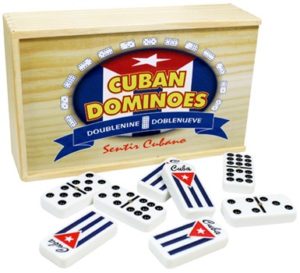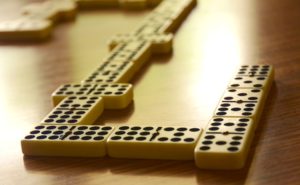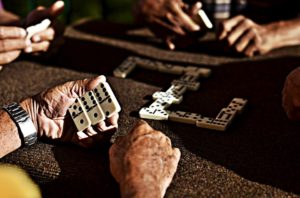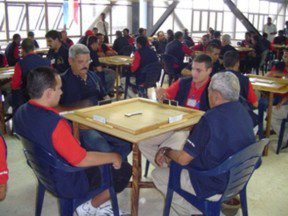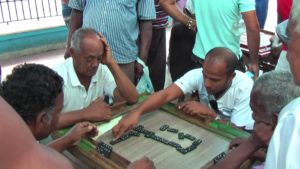The domino in Cuba is one of the most enjoyable entertainment, without a doubt.
As the saying goes, “There is no Saturday without sun”, nor is there a Cuban party without dominoes. This old board game has won the throne of Cuban tables. Although it has been known for centuries in Havana, today it is a very popular game and the favorite of all Cubans.
The domino was born in China, back in the 10th century, and soon spread throughout Europe. Today, in all Cuban neighborhoods there is a table for dominoes, and even a table serves to play: it is supported by the legs of the four domino players and ready … to give water to the chips.
Today the domino brings together players of all ages and has become one of the symbols that best represents Cubans, because in this game their personality is expressed by the choteo, the gestures and the refrain that identify this town.
In Cuba there are two types of dominoes: the oriental one that uses 28 cards, with combinations from 1 to 6, which is very popular in this area of the Island; and the one played in the West that has 55 chips, which goes up to 9. It can be played in pairs (two against two) or “one for solo”, where more players can participate.
Name of tabs
The chips with the same number of points in both squares are known as doubles, mules, pigs or carts. Also, chips with one of the squares without points are called white or chucha, and those with a point are known as whistles or ones. So, with the twos, treses, fours and fives until reaching the sixes. In other places they are usually named Blanco (0), As (1), Dos (2), Tres (3), Cuadra (4), Quina (5) and Sena (6)
Players
The game is usually played by four players in pairs. It can also be played alone.
Game development
In his turn each player will place one of his pieces with the restriction that two pieces can only be placed together when the adjacent squares are of the same value (eg 1 with 1, 2 with 2, etc. up to 6) . It is customary to place the doubles crosswise. Placing a double is often called bending, or lying down.
If a player can not place a chip on his turn he will have to pass the turn to the next player. It is common in the game that one of the players pulls, for example, the last of the six remaining only by throwing the double six. In this case it is said that he has hanged or killed the double six. The player who has it will not be able to win the round (unless his partner wins).
End of the game
The hand continues until one of the two situations occurs:
Some of the players are left without chips to place on the table. In this case the player is said to have dominated the game.
In case of closing, lock or lock, that is to say, when in spite of remaining chips in play none can be placed, the player or pair will win whose chips add less points.
This only happens when the same number is in both ends of the game, and the seven chips of that number have already been played in this case the pair / player who has the least points in their chips wins, and the loser points are added to the winner.
Goal
The objective of the game is to reach a certain previously fixed score, playing for it the hands or rounds that are precise. The player who wins a round, adds the points of the chips of his opponents and / or pair. The first player or pair that reaches the score set at the beginning of the game wins.
The only valid sign in the domino game is the “thought”. When it is your turn to play, you have the option of thinking for a relatively long time to make your teammate understand that you have several chips of the same number that you are going to cover or that you are going to square. Or on the contrary, playing immediately, without thinking, indicates that you do not have more chips of that number.
It can also be used to confuse the opposite, making people believe that they have, or not, several chips of the same number when in fact it is not like that. This is called “thinking false” and in some modalities the game is not allowed.
In the streets of Havana dominoes are played with such passion that many reach heated arguments; but this hobby is, for many Cubans, more than a simple game, it is a way to join young and old, men and women, and to spend moments between joys and traditions.
In the domino in Cuba, a phenomenon happens that is not yet explained by the most brilliant psychologist. It is a game where the chips of the table are shared between couples (any version the western or the oriental, which is the most widespread), in the midst of people who may be drinking rum, giving opinions to shouts or under a hulking silence and most curious and worth noting is that the loser, his defeat is commented noisily, but its effect is dissolved and forgotten so quickly that avoids the displeasure or possible confrontation of the unfortunate loser.
Surpassed only by baseball as a national sport, there is no doubt that this game is one of the most widespread pastimes throughout the Cuban archipelago, besides being the board game par excellence among friends and neighbors of the neighborhood.
EL DOMINÓ, EL JUEGO QUE HA GANADO EL TRONO DE LAS MESAS CUBANAS.
El dominó en Cuba es uno de los entretenimientos que mas gustan, sin lugar a dudas.
Como dice el dicho que «No hay sábado sin sol», ni tampoco hay fiesta cubana sin dominó. Este antiguo juego de mesa se ha ganado el trono de las mesas cubanas. Aunque hace siglos que se conoce en La Habana, hoy es un juego muy popular y el preferido de todos los cubanos.
El dominó nació en China, por allá por el siglo X, y pronto se extendió por Europa. Hoy, en todos los barrios cubanos hay una mesa para el dominó, y hasta una tabla sirve para jugar: se apoya en las piernas de los cuatro jugadores del dominó y listo… a darle agua a las fichas.
Hoy el dominó reúne jugadores de todas las edades y se ha convertido en uno de los símbolos que mejor representa a los cubanos, porque en este juego se exterioriza su personalidad el choteo, los gestos y el refranero que identifican a este pueblo.
En Cuba hay dos tipos de dominós: el oriental que emplean 28 fichas, con combinaciones del 1 al 6, que es muy popular en esta zona de la Isla; y el que se juega en occidente que tiene 55 fichas, que llega hasta el 9. Se puede jugar en parejas (dos contra dos) o «un solo para solo», donde pueden participar más jugadores.
Nombre de las fichas
Las fichas con igual número de puntos en ambos cuadrados se conocen como dobles, mulas, chanchos o carretas. Asimismo, las fichas con uno de los cuadrados sin puntos se llaman blancas o chucha, y las que tienen un punto se conocen como pitos o unos. Así, con los doses, treses, cuatros y cincos hasta llegar a los seises. En otros lugares suelen ser nombrados Blanco(0), As(1), Dos(2), Tres(3), Cuadra(4), Quina(5) y Sena(6)
Jugadores
El juego generalmente se juega de a cuatro jugadores en parejas. También puede jugarse en solitario.
Desarrollo del juego
En su turno cada jugador colocará una de sus piezas con la restricción de que dos piezas sólo pueden colocarse juntas cuando los cuadrados adyacentes sean del mismo valor (ej. el 1 con el 1, el 2 con el 2, etc. hasta el 6). Es costumbre colocar los dobles de forma transversal. Colocar un doble suele llamarse doblarse, o acostarse.
Si un jugador no puede colocar ninguna ficha en su turno tendrá que pasar el turno al siguiente jugador. Es frecuente en el juego que alguno de los jugadores tire, por ejemplo, el último de los seises quedando únicamente por tirar el seis doble. En este caso se dice que ha ahorcado o matado el seis doble. El jugador que lo tenga no podrá ya ganar la ronda (a no ser que la gane su compañero).
Final del juego
La mano continúa hasta que se da alguna de las dos situaciones:
Alguno de los jugadores se queda sin fichas por colocar en la mesa. En este caso el jugador se dice que dominó la partida.
En caso de cierre, tranca o tranque, es decir, cuando a pesar de quedar fichas en juego ninguna pueda colocarse, ganará el jugador o pareja cuyas fichas sumen menos puntos.
Esto solamente sucede cuando el mismo número está en ambos extremos del juego, y las siete fichas de ese número ya han sido jugadas en este caso gana la pareja/jugador que menos puntos tenga en sus fichas, y se le suman los puntos del perdedor al ganador.
Objetivo
El objetivo del juego es alcanzar una determinada puntuación previamente fijada, jugando para ello las manos o rondas que sean precisas. El jugador que gana una ronda, suma los puntos de las fichas de sus adversarios y/o pareja. El primer jugador o pareja que alcanza la puntuación fijada al principio de la partida, gana.
La única seña válida en el juego del dominó es la “pensada”. Cuando toca el turno de jugar, se tiene la opción de pensar durante un tiempo relativamente largo para hacerle entender al compañero que se tienen varias fichas del mismo número que va a tapar o que va a cuadrar. O por el contrario, jugar de inmediato, sin pensar, indica que no se tienen más fichas de ese número.
También se puede usar para confundir al contrario, haciendo creer que se tienen, o no, varias fichas de un mismo número cuando en realidad no es así. Esto se llama “pensar en falso” y en algunas modalidades del juego no es permitido.
En las calles de La Habana el dominó se juega con tanta pasión que muchos llegan a acaloradas discusiones; pero este pasatiempo es, para muchos cubanos, más que un simple juego, es una manera de unirse jóvenes y viejos, hombres y mujeres, y pasar momentos entre alegrías y tradiciones.
En el dominó en Cuba sucede un fenómeno que todavía no es explicado ni por el más brillante psicólogo. Es un juego donde se comparten las fichas de la mesa entre parejas (cualquier versión la occidental o la oriental, que es la más difundida), en medio de personas que pueden estar bebiendo ron, opinando a gritos o bajo un descomunal silencio y lo más curioso y digno de destacar es que el que pierde, su derrota es comentada ruidosamente, pero su efecto se disuelve y olvida con tal rapidez que evita el disgusto o la posible confrontación del desafortunado perdedor.
Superado únicamente por el béisbol como deporte nacional, no hay dudas de que este juego es uno de los pasatiempos más difundidos por todo el archipiélago cubano, además de ser el juego de mesa por excelencia entre amigos y vecinos de la barriada.
Agencies/Wiki/Alarcón/Internet Photos/YouTube/Arnoldo Varona/TheCubanHistory.com
THE CUBAN HISTORY, HOLLYWOOD.



